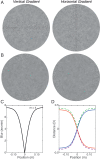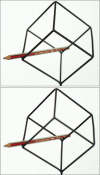The natural statistics of blur
- PMID: 27580043
- PMCID: PMC5015925
- DOI: 10.1167/16.10.23
The natural statistics of blur
Abstract
Blur from defocus can be both useful and detrimental for visual perception: It can be useful as a source of depth information and detrimental because it degrades image quality. We examined these aspects of blur by measuring the natural statistics of defocus blur across the visual field. Participants wore an eye-and-scene tracker that measured gaze direction, pupil diameter, and scene distances as they performed everyday tasks. We found that blur magnitude increases with increasing eccentricity. There is a vertical gradient in the distances that generate defocus blur: Blur below the fovea is generally due to scene points nearer than fixation; blur above the fovea is mostly due to points farther than fixation. There is no systematic horizontal gradient. Large blurs are generally caused by points farther rather than nearer than fixation. Consistent with the statistics, participants in a perceptual experiment perceived vertical blur gradients as slanted top-back whereas horizontal gradients were perceived equally as left-back and right-back. The tendency for people to see sharp as near and blurred as far is also consistent with the observed statistics. We calculated how many observations will be perceived as unsharp and found that perceptible blur is rare. Finally, we found that eye shape in ground-dwelling animals conforms to that required to put likely distances in best focus.
Figures




















References
-
- Brisson J,, Mainville M,, Mailloux D,, Beaulieu C,, Serres J,, Sirois S. (2013). Pupil diameter measurement errors as a function of gaze direction in corneal reflection eyetrackers. Behavior Research Methods, 45, 1322–1331. - PubMed
-
- Campbell F. W. (1957). The depth of field of the human eye. Optica Acta, 4, 157–164.
-
- Campbell F. W,, Westheimer G. (1958). Sensitivity of the eye to differences in focus. Journal of Physiology, 143, 18P.
MeSH terms
LinkOut - more resources
Full Text Sources
Other Literature Sources
Medical

